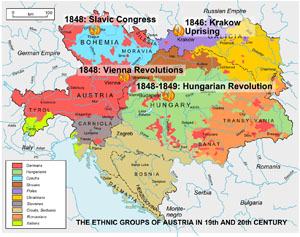3. The Austrian Empire – a country of many nations. Map of nationalities included in the Habsburg state
 Click image to enlarge
Click image to enlarge
http://commons.wikimedia.org/wiki/File:Austria_Hungary_ethnic.svg
Questions
Description and Analysis
- By analysing the map of nationalities of the Habsburg state, consider what kind of problems, social conflicts could arise from such a varied ethnic and cultural composition of society?
Such a diverse social composition meant that one country was populated by people of different languages, religions and traditions. Therefore, there had to be conflicts between them concerning these issues. It was difficult to force people in the entire country to follow one official religion, to use the same official language, and celebrate the same holidays. Some nations might feel discriminated in relation to others. - By analyzing the map, point out nationalities that took action to obtain political freedom during the Spring of Nations.
Poles began struggle to gain independency or political or cultural freedom already in 1846 during the Krakow Uprising. In 1848 there was a revolution in Vienna. In the same year there was Slavic Congress held in Prague. Hungarians continue the fight to obtain sovereignty for two years. - By analysing the ethnic map, specify the location of the German population in relation to other nations making up the state of the Habsburgs.
German-speaking population lived only in western territories of the Empire. Germans constituted a minority in relation to other nations making up the state, but at the same time, they were the most privileged.
Geographical/Historical Context
Austria was in a special situation during the Spring of Nations. It was during that time that problems resulting from multinational and multicultural society of the country came up with full force. During the events of 1848 and 1849, in the Austrian Empire there was an escalation of conflicts of a political (rising of the population of Vienna), social (peasant uprising in Galicia), and national nature (Krakow Uprising, Hungarian uprising, the Prague Slavic Congress). The complex social and administrative structure of the empire caused that (apart from rising of an anti-German nature) there was also a movement against Hungarians. Nations whose lands were located within the former Hungarian state felt oppressed by the Magyars. The materials prepared for students focus on the national liberation events in the country of the Habsburgs.
Already in March 1848, the Hungarians voiced their demands of a national parliament, ministers held responsible before the parliament, reforms in the country, and freedom of speech and assembly. Ferdinand I of Austria, who had to face at the same time the Italian war and events in Vienna, initially agreed to the demands of the Hungarians. This agreement caused an avalanche of similar requests submitted by other nations which lived in the Austrian state.
Also in March, the National Committee was established in Prague. Also the petition demanding political and national liberties for the Czech people was submitted to the emperor. At the same time, Croatians stated their demands of recognition of the national language in administration and creating a national army. The authorities in Vienna (when their position was clearly weakened by military operations on several fronts) agreed to make concessions. They promised to introduce liberalizing reforms of the state and improve the peasantry situation in the country. Privileges for German and Hungarian populations were for a long time causing discontent among Slavic nations which together constituted the majority in the country. During the Spring of Nations, therefore, they formulated a program of transformation of the Habsburg monarchy into a federal state where the three main ethnic groups (German, Hungarian and Slavic) would have equal participation in making decisions concerning the state. The Slavic Congress in Prague began under such slogans in June 1848. The congress was attended by representatives of the following nations: Czech, Polish, Croatian, Serbian, Slovak, Slovenian, and Ukrainian. The debate was interrupted by the uprising in Prague, which was quickly suppressed by the Austrian army. Austrians also took the opportunity to break up the Slavic Congress.
The Hungarian course of events, however, took the most dramatic form. The authorities in Vienna were not keeping the promises made to Hungary in 1848. In March 1849, the new emperor (Franz Joseph I) incorporated Hungary into the empire, which negated the independence of Hungary. The Magyars’ reaction was dethronement of the Habsburgs, declaration of independence, and a bloody war of national liberation that was ended only by the intervention of Russian troops.
While the liberation movements of all the nations forming the Austrian state were suppressed in 1848 and 1849, it was clear that without thorough political reforms, the multinational character of this political creation would sooner or later become the cause of its collapse.
Links
Pages devoted to the definitions and the issue of multinational and multicultural countries in history of the world and today:
http://www.ceo.org.pl/portal/slady_materialy_doc?docId=46539
http://www.wos.org.pl/narod.html
http://www.zgapa.pl/zgapedia/Pa%C5%84stwo_wielonarodowe.html
http://www.bryk.pl/teksty/liceum/historia/xx_wiek/24428-ii_rzeczpospolita_pa%C5%84stwo_wielonarodowe.html – Second Polish Republic as an example of a multinational state.




Presentation
The Austrian Empire was a multinational state. It was constituted by over a dozen of nations with different languages, cultures, traditions, religions. What is more, the ruling nation (Germans) did not represent the majority of the population of this country. The Habsburg state was exposed to a series of conflicts because of these factors. It was a common demand to use mother tongue in administration in addition to the official German language. People were demanding the freedom of religion. The Roman Catholics, Greek Catholics, Protestants, and Orthodox lived in the Empire. Most of the nationalities shown on the map already during the Spring of Nations began to show ambitions to obtain political freedom or complete independence.